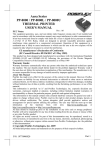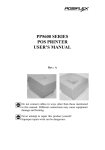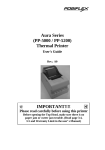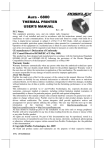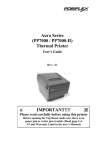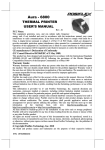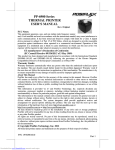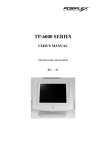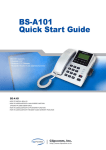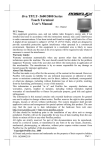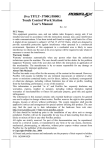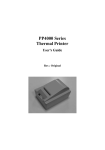Download POSIFLEX Business Machines PP7700 Series Printer User Manual
Transcript
Aura PP7700 Series Wireless POS Thermal Printer User's Guide Rev.: Original IMPORTANT!!!! Please read carefully before using this printer Before opening the Top Hood, make sure there is no paper jam or cutter jam trouble. (Read page 3-4, 3-5 and Warranty Limit in the user’s Manual.) Federal Communications Commission Radio Frequency Interference Statement This equipment has been tested and found to comply with the limits for a Class A digital device, pursuant to Part 15 of the FCC Rules. Thes e limits are designed to provide reasonable protection against harmful interference when the equipment is operated in a commercial environment. This equipment generates, uses, and can radiate radio frequency energy and, if not installed and used in accordance with the instruction manual, may cause harmful interference to radio communications. Operation of this equipment in a residential area is likely to cause harmful interference in which case the user will be required to correct the interference at his own expense. For compliance with Federal Noise Interference Standard, this equipment requires a shielded cable. This statement will be applied only for the printers marketed in U.S.A. CE manufacturer’s Declaration of Conformity (EC Council Directive 89/336/EEC of 3 May 1989) This product has been designed and manufactured in accordance with the International Standards EN50081-1/01.92 and EN50082-1/01.92 following the provisions of the Electro Magnetic Compatibility Directive of the European Communities as of May 1989 Warranty Limits Warranty will terminate automatically when the machine is opened by any person other than the authorized technicians. The user should consult his/her dealer for the problem happened. Warranty voids if the user does not follow the instructions in application of this merchandise. The manufacturer is by no means responsible for any damage or hazard caused by improper application. About This Manual This manual is aimed to assist the user to utilize the Aura (PP7700) series which is a series of wireless POS thermal printers delicately designed to work with either serial or parallel interface connection. This manual covers both operational and technical aspects. This manual covers also the Epson emulation commands and some special features of the printer. The manufacturer of the Aura (PP7700) series heartily apologizes to the user for reserving the right to change or to modify this manual without notice due to the rapid and constant progress and improvement on science and technology. The user may always obtain the most up to date information through our web sites: http://www.posiflex.com.tw or http://www.posiflex.com © Copyright Posiflex Inc. 2004 All rights are strictly reserved. No part of this documentation may be reproduced, stored in a retrieval system, or transmitted in any form or by any means, electronic, mechanical, photocopying, or otherwise, without the prior written consent of Posiflex Inc. the publisher of this documentation. Other brand and product names are trademarks and registered trademarks and service marks of their respective owners. P/N: 19300900010 Table Of Contents GETTING STARTED . . . . . . . . . . . . . . . . . . . . .1 CONGRATULATION . . . . . . . . . . . . . . . . . . . . . .1 PRODUCT BRIEFING . . . . . . . . . . . . . . . . . . . . . 1 UNPACKING . . . . . . . . . . . . . . . . . . . . . . . . . . . . . 1 OPTIONS . . . . . . . . . . . . . . . . . . . . . . . . . . . . . . . . 1 MAIN PARTS ON THE EXTERIOR . . . . . . . . . 1 INDICATORS . . . . . . . . . . . . . . . . . . . . . . . . . . . . 1 OPERATING ENVIRONMENT . . . . . . . . . . . . .1 USEFUL TIPS . . . . . . . . . . . . . . . . . . . . . . . . . . . . 1 QUICK START-UP . . . . . . . . . . . . . . . . . . . . . . . . 2 ---------- 1 1 1 2 2 3 4 4 5 -- 1 LOADING PAPER . . . . . . . . . . . . . . . . . . . . . . . . .2 -- 1 Desk Top Application . . . . . . . . . . . . . . . . . . .2 -- 1 When To Replace Paper . . . . . . . . . . . . . . . . . 2 -- 2 CONNECTION/SET UP . . . . . . . . . . . . . . . . . . . . 2 -- 2 Serial Connection . . . . . . . . . . . . . . . . . . . . . . .2 -- 2 Wireless Connection . . . . . . . . . . . . . . . . . . . . 2 -- 2 General concepts . . . . . . . . . . . . . . . . . . . . . . 2 -- 2 Physical and driver installation . . . . . . . . . . 2 -- 3 Making wireless connection . . . . . . . . . . . . . 2 -- 7 Automatic re-connection at power on . . . . 2 -- 9 Flexible wireless connection . . . . . . . . . . . . .2 -- 9 Signal Detection (to select a proper printer location) . . . . . . . . . . . . . . . . . . . . . . . . . . . . . . . . . . . . . . 2 -- 10 Peripheral Connection . . . . . . . . . . . . . . . . . . 2 -- 11 Power Connection . . . . . . . . . . . . . . . . . . . . . . 2 -- 12 Power On . . . . . . . . . . . . . . . . . . . . . . . . . . . . . 2 -- 12 Self Test . . . . . . . . . . . . . . . . . . . . . . . . . . . . . . 2 -- 12 SPECIAL ADJUSTMENTS . . . . . . . . . . . . . . . . . 2 -- 13 Paper Near End Sensor . . . . . . . . . . . . . . . . . 2 -- 13 Paper Roll Placement . . . . . . . . . . . . . . . . . . . 2 -- 14 i Spacer Plate . . . . . . . . . . . . . . . . . . . . . . . . . . . 2 -- 14 Paper Cutting . . . . . . . . . . . . . . . . . . . . . . . . . .2 -- 15 Wall Mount Application . . . . . . . . . . . . . . . . . 2 -- 15 MAINTENANCE GUIDES . . . . . . . . . . . . . . . . . . . . 3 -- 1 MAINTENANCE GUIDE LINES . . . . . . . . . . . . 3 GENERAL CLEANING . . . . . . . . . . . . . . . . . . . .3 PRINT HEAD CLEANING . . . . . . . . . . . . . . . . . 3 TROUBLE SHOOTING . . . . . . . . . . . . . . . . . . . .3 General Problems . . . . . . . . . . . . . . . . . . . . . . 3 Printing Problems . . . . . . . . . . . . . . . . . . . . . . 3 Paper Jam Problems . . . . . . . . . . . . . . . . . . . . 3 Auto Cutter Problems . . . . . . . . . . . . . . . . . . . 3 Graphic Printer Speed . . . . . . . . . . . . . . . . . . 3 Wireless Connection Concerns . . . . . . . . . . . . 3 Advanced Analysis Tool . . . . . . . . . . . . . . . . .3 ------------ 1 1 1 2 2 2 4 4 5 5 7 SPECIFICATIONS . . . . . . . . . . . . . . . . . . . . . . . . . . . 4 -- 1 PRINTER . . . . . . . . . . . . . . . . . . . . . . . . . . . . . . . . 4 -- 1 PAPER . . . . . . . . . . . . . . . . . . . . . . . . . . . . . . . . . . .4 -- 1 POWER ADAPTOR . . . . . . . . . . . . . . . . . . . . . . . 4 -- 2 TECHNICAL INFORMATION . . . . . . . . . . . . . . . . 5 -- 1 INTERFACES . . . . . . . . . . . . . . . . . . . . . . . . . . . . 5 Wireless Interface . . . . . . . . . . . . . . . . . . . . . . 5 Peripheral Interface . . . . . . . . . . . . . . . . . . . . 5 SETUP WINDOW . . . . . . . . . . . . . . . . . . . . . . . . .5 INTERNAL SWITCH . . . . . . . . . . . . . . . . . . . . . . 5 SOFTWARE COMMANDS . . . . . . . . . . . . . . . . .5 Paper Out Alarm . . . . . . . . . . . . . . . . . . . . . . . 5 Enhancement Commands . . . . . . . . . . . . . . . . 5 CHARACTER CODE PAGES . . . . . . . . . . . . . . . 5 ii ---------- 1 1 2 2 4 5 5 5 7 I. GETTING STARTED A. CONGRATULATION You have made a very wise decision by purchasing the easy loading; low noise; high resolution; light weight; high reliability wireless thermal printer Aura PP7700 series of Posiflex products. This series of printers has been elegantly designed for a Point-OfSale, kitchen & kiosk application. The manufacturer of this printer not only wishes to take this opportunity to congratulate your smart investment on buying this printer but also likes to express the wishes for your prosperous future by using it. B. PRODUCT BRIEFING The Aura PP7700 series communicates to a Dongle installed on a COM port of Posiflex POS system through a wireless way and performs thermal printing particularly designed for POS applications. This unique wireless communication architecture not only frees the user from messy cabling setup in multiple host vs. multiple printer environment but also provides the easiest adaptability for conventional POS software to utilize the cutting edge technology with least modification needs. The Aura PP7700 series printer uses thermal sensitive paper in form of a roll at a width of 80 mm (standard) or 58 mm (option). The Aura PP7700 series printer serves the stand-alone desk top application as well as the application within a Posiflex integrated POS system equally perfect. The Aura PP7700 supports a guillotine type auto cutter for paper partial cut and a manual cut mechanism. The Aura series also supports user’s company’s LOGO downloading for superior performance. It even supports some enhancement capability for 1-1 reminder function to persons around. It can be used to drive a separately purchased kitchen bell for such reminder function in noisy environment. This printer also supports application in different countries of various kinds of power systems by changin g the power cord to the power adaptor. C. UNPACKING Followings are items you may find when you carefully unpack the carton that delivers Aura series printer. If there is any discrepancy or problem, contact your dealer immediately. Be sure to save the packing materials in case the printer needs to be shipped at some point in the future. • ‚ ƒ „ The printer itself Thermal paper roll 80 mm wide One piece of spacer plate One of the power sources: a Power adaptor + power cord (depend on country type ordered). b Power supply cable (when no power adaptor ordered) This printer power supply cable is used to supply power to the printer from the Posiflex POS system. … This User’s Manual D. OPTIONS • 58 mm paper guide adaptor (can be modified at distributor’s site only) • Kitchen bell • Wall mount kit 1-2 • Language to add to standard model: Japanese Kanji; Korean; Traditional Chinese or Simplified Chinese E. MAIN PARTS ON THE EXTERIOR Top Hood Power LED Error LED Paper Out LED Top Cover FEED Switch Cutter Cover Bottom Cover Power Switch Hood Release Front View Power Switch Rear View Antenna Frame Ground Power Connector 1-3 Serial Connector Peripheral Connector Bottom View Screws Setup Window Window Plate Screw F. INDICATORS • Power LED: green • Error LED: red • Paper Out LED: red G. OPERATING ENVIRONMENT • Place the printer on a sturdy, level surface. • Choose a place that is well ventilated and free of excessive dust, smoke or fume. • Do not put the printer under direct sunlight or near a heater. • Avoid such environment with large number or size of metal objects in the neighborhood for siting of either the wireless printer or the wireless Dongle (connected to the host) 1-4 • Try to prevent as much as possible any obstacle between printer and host PC such as metal plate, wire mesh or any other materials of metal. • Ideal room temperature is from 5ºC to 40ºC. Ideal humidity is from 20% to 85% RH (no condensation). • Use a grounded AC power outlet. • Use only the power cord and power adaptor furnished with the printer. • Do not use a power outlet of a circuit shared with any equipment that causes great electrical noise, such as motors. • Do not use a power outlet of a circuit shared with any equipment that uses a lot of power, such as a copier or a coffee maker. • Do not touch any connector contacts to avoid possible electrostatic damage. • Do not allow the cut receipt to slide back into the cutter during the operation. As this would lead to multiple cutting at the lower edge of a receipt and the multiple cut thin slips tend to cause mechanical malfunction. • Since the paper roll is highly thermal sensitive, please keep them in a dark place that is 20º and 65% RH when not installed in the printer. H. USEFUL TIPS • Do not touch the areas around the print head and motor during or right after printing. It can be very hot. 1-5 • Do not use thermal paper containing Sodium (Na+), Potassium (K+) and Chlorine (Cl-) ions that can harm the print head thermal elements. • Use only water paste, starch paste, polyvinyl paste or CMC paste when gluing thermal paper. • Use of volatile organic solvents such as alcohol, ester and ketone on thermal paper can cause discoloration. • Some adhesive tapes on thermal paper may cause discoloration or faded printing. • Use only products made from polyethylene, polypropylene or polyester for storage of thermal paper. If thermal paper touches anything includes phthalic acid ester plasticizer for a long time, the image formation ability may be reduced or the printed image may fade. • If thermal paper touches diazzo copy paper immediately after copying, the printed surface may be discolored. • Thermal paper must not be stored with the printed surfaces against each other as the printing may be transferred between the surfaces. • If the surface of thermal paper is scratched with a hard object such as a nail, the paper may become discolored. • Store thermal paper away from high temperature and humidity. Avoid extended exposure to direct light. • Do not set any liquid or drinks such as coffee on the printer case 1-6 II. QUICK START-UP A. LOADING PAPER 1. Desk Top Application 1. 2. Slide the hood lock toward the front of the printer to release the hood. Raise the released hood wide open manually. 3. Drop the thermal paper roll inside the printer in the orientation as shown in the picture. 4. Close the hood back leaving the tail of the paper roll coming out of the opening between the hood and the top cover. Tear off excessive paper. 2-1 2. When To Replace Paper Whenever the printer gives paper out signal or a red line appears on the thermal paper, it is the proper timing for replacing the paper. Do not wait till the print engine is dragging the paper roll at the very end. It is recommended not to turn off the power only for paper replacement for this model. However, please pay extreme attention not to touch the still hot thermal elements or any electrically live part. Remove the leftover and replace a new paper roll as illustrated above to prevent excessive paper dust in the printer and consequently possibility for paper jam. B. CONNECTION / SET UP 1. Serial Connection All the external connectors are in the recessed area at the rear bottom. The serial connector should be used only in specific technical applications like debug testing or firmware upgrade. Nothing should be connected to this port in normal operation. 2. Wireless Connection a. General concepts The standard PP7700 delivered is equipped with the wireless interface. A wireless Dongle DG2000 to control this printer must be separately purchased and installed to one of the serial COM ports of Posiflex POS system. We know that usual wireless printer solutions require the application software to use the printer server in WLAN. In distinction, the Posiflex wireless 2-2 connection supports a genuine virtual cable connection thus supports the application software to use even the so-called direct I/O method for controlling the printer. The Posiflex wireless connection supports various application environments from having single Dongle to control single wireless printer to having single Dongle to control multiple wireless printers and further to having multiple Dongles to control multiple wireless printers as long as certain discipline in printer-Dongle connection and disconnection procedures are well organized in the application program. In general practice, the application program provided by system integrators should have included the programming elements for the Posiflex wireless connection driver and the user should follow the arrangement of the application program accordingly. However, if the software did not take care of the wireless connection, the user may install the relevant driver prior to the execution of the application software. The driver can be found together in delivery of the wireless printer or the Posiflex Product Information CD of version 1.9 or above, or please visit our web http://www.posiflex.com or http://www.posiflex.com.tw for it. Procedures below are applicable to the situation that the wireless connection is not covered by the application program only. b. Physical and driver installation 1. Select a place free from strong RF interferences and metal objects for set-up of the wireless printer. Do the Dongle installation according to its installation guide. Avoid excessive obstacles such as metal plate, wire mesh or RC wall etc. in between. Refer to section “Signal detection” for help to find the most suitable position setup as the radio frequency signals are concerned. 2-3 At the host system that the Dongle is connected, be sure to terminate any application program or to uninstall any driver occupying the COM port that the Dongle is connected. Select the proper COM port if requested by the installation program. If there are multiple Dongles installed on several COM ports in the host, you have to free all COM ports to be used for wireless connection before driver installation and select the COM ports used one by one if requested in the installation program. Reboot system after installation complete. Detail illustrations are as below. First copy or decompress the drivers to a subfolder in the host system where Dongle DG2000 is attached. Then in the host system click “Start” --> “Settings” --> “Control Panel” --> “System” –> “Hardware” –“Device Manager” --> “COM & LPT”. Click the right button of mouse at the COM port that DG2000 is attached and select “Update Driver” as below. 2. 2-4 In “Hardware Update Wizard” that appears after this, choose “Install from a list or specific location (Advanced)” --> “Don’t search, I will choose the driver to install” --> “Have Disk” --> “Browse” and find the subfolder where the drivers were stored. Select “ComBtDrv.inf”. Click “Open” --> “OK”, “Posiflex Wireless Dongle” and a warning message on digital signature will show up in “Hardware Update Wizard”. 2-5 Ignore this message and click “Next”, a warning dialogue box will pop up. Select “Continue Anyway” to exit the “Hardware Installation.” warning dialogue box 2-6 Click Finish to close the wizard. Check that in “Device Manager” the “Communications Port” should be changed to “Posiflex Wireless Dongle” to conclude the driver installation. c. Making wireless connection 1. Please follow instruction of the application program if it covers the wireless connection because it may then utilize some more practical naming of the wireless printer in use. Follow procedures below for first time connecting a wireless printer to the Dongle if the application program does not take care of this part. 2. Please find under the bottom of the wireless printer PP7700 that you want to connect a BT ID printed on a label near the serial number. Write it down on a piece of paper for later 2-7 setup procedure since this BT ID could mean lengthy and hard to memorize by heart to average people. 3. At the host system that the Dongle is connected, first make sure that the COM port is exclusively free for Posiflex wireless connection. Then execute the “Posiflex Wireless Printer Setup” (or “BTSetUp.exe” as filename) and select the COM port that the Dongle is connected. If there are more than one Dongle connected in a host system, please do the setup procedure for one Dongle at a time. 4. Check in the above screen that when the Dongle is well installed and recognized by the software a 12 digit Dongle ID will appear in the field for “HOST: BT Address”. Double check the installation if it still shows “NONE” here. Do a “Query Printer” and in the “PRINTER” field all BT ID of the wireless printers within communication range will be displayed. Select the BT ID that match the one for wireless printing that you wrote down previously. Clicking for “Connect” will engage that printer to be connected to the 2-8 COM port of the Dongle as if they were physically connected. In other words, you may now send all command / data to the COM port with Dongle to control / print at the PP7700 without excessive restrictions. You may then select for next COM port, do another “Query Printer” and another “Connect” for next Dongle if it exists. d. Automatic re-connection at power on One of the advantages with Posiflex wireless connection is that it mimics a real physical cable connection very faithfully. Whenever you connected a POS printer to a COM port in the host system, you would expect the connection remains there if you power off and back on either the host or the printer before you make the “Disconnect” operation. This would be particularly important in the more or less straightforward application on fixed port (Dongle)-printer-pair relationship with multiple Dongles and multiple printers in the overall space but enjoying the convenience of no messy cables. This is default supported in Posiflex wireless connection. 2. If for any reason this automatic reconnection at power up is disabled, you may re-activate this function by including a program shortcut in the system “StartUp” menu. Please include the software parameter select “BTSetUp.exe /X /C” in the shortcut. 1. 1. e. Flexible wireless connection Average wireless printer utilizing printer server concept in WLAN provides good flexibility for multiple hosts to print on multiple printers. Posiflex managed for POS application something more than the flexibility in its wireless connection in a different approach. It concerns the controlling Dongle (host) and the wireless POS printer in the print task execution. Considering the fact that most POS printers operate on a “Line Print” basis, if several print jobs from one host have to 2-9 be carried out consecutively while unfortunately at the same time another print job is sent from another terminal, without the exclusive function, the printer may perform a confusing interlaced print as the combined result. 2. The security of exclusive relationship is achieved at the cost of discipline for “Disconnect” operation. To obtain flexible connection in the multiple Dongles multiple wireless printers environment, the “Disconnect” must be exercised by the application program or by manual after each meaningful finish of print job(s). The programmer may refer to “BTLoader.txt” in the driver to have the process done in an AP. To “Disconnect” manually, please select “NONE” selected in the “PRINTER” field of “BTsetup.exe” and click “Connect”. Then the Dongle can be connected to another wireless printer and that wireless printer can be freed for connection to other Dongle if required. 3. Signal Detection (to select a proper printer location) The Posiflex wireless printer PP7700 is designed and manufactured to operate within 100 meters distance from the correspondent Dongle in free space. However, in the real world the Electro-Magnetic wave propagation is greatly influenced by the surrounding environment and the relative antenna setup. As a general guidance, arranging the wireless printer and the Dongle in a horizontal plane of same height and their antennas to be parallel to each other and also away from the machine body or any metal yields best performance in most cases. To get a best communication performance there is a very important Posiflex provided “Signal detect” feature to help users in determining the most suitable location setup for the wireless printer. Please first remove the paper roll out of PP7700 and connect power to it as described in coming section. Turning on 2 - 10 the power while the “Feed” button is pressed can prepare PP7700 for the signal detect operation. Now in the host Posiflex POS system, please execute the “Connect” with the BT ID of the PP7700 entered in the appropriate field and click for “Connect”. Ignore any warning message that would popup later. Press the “Feed” button on PP7700 again and PP7700 will flash its Error LED to indicate the wireless connection condition. The faster the LED flash (up to a little bit faster than 1 flash / sec) indicates a better connection condition. If the signal detect signal flashes too slow or even steady on or off, it may need to shorten the printer -host distance or to check the environment again and you may move the PP7700 around and adjust the antenna direction before final decision on location setup. Please adjust the position of the host system and Dongle antenna direction when necessary. It is quite commonly experienced that several centimeter move or turning the directions of either the host or the printer can make significant influences. Please also take into consideration the operation area of operating personnel as human body usually influences wireless communication a lot. After fixing the location setup you may turn off PP7700 and reload the paper roll to prepare for normal operation. Terminate the “Signal detect” function at the host and go for application program at the host system. 4. Peripheral Connection The peripheral controller is a RJ11 jack near the serial connector. With use of Posiflex cash drawer cable 20863018001 (CCBLA-180-1) come with cash drawer, this port can control a Posiflex cash drawer CR3100 or CR3200 or CR4000 or CR4100. If a Posiflex special split cable 20867023800 (CCBLA-238) is used instead, this port can control two cash drawers of above models. 2 - 11 When the printer is used as a kitchen printer and a kitchen bell is prepared, please use this port for kitchen bell connection instead. 5. Power Connection The power connector is a 3 pin jack next to the peripheral connector. Either a Posiflex supplied power adaptor or a printer power cable from a Posiflex POS system can be connected to this connector to supply power for this printer. During insertion of the power plug, be sure to hear the click to obtain a firm contact. CAUTION: Before doing the insertion or extraction of the power plug, be sure to pull the outer sleeve of the plug backward to release the internal latch. Failure to do this could damage the power plug. Such damage is considered as an artificial destruction and is not covered by the warranty. 6. Power On When all the above cable connections are made correctly, you may connect your power adaptor to the wall outlet. Make sure that the type of power cord and the voltage requirement of the power adaptor meet the local power conditions. Now the printer is ready for power on. 7. Self Test With the paper roll loaded in the printer press and hold down the feed button while push the on / off switch on. The printer will then perform a self test. A sample slip of self test result is printed below. The header of this slip is printed in text mode and the rest part is in page mode. If FEED button is pressed at this moment, a 2 - 12 font table will be printed in text mode again. To exit the test printing, please turn the printer off and on again. C. SPECIAL ADJUSTMENTS 1. Paper Near End Sensor The near end sensor for paper roll in the printer is now able to have the printer work with paper rolls of several bobbin sizes. Please refer to the picture at right from inside the paper roll compartment that there are a fixing screw and a sensor head in the wall. 2 - 13 Fixing Screw Sensor Head Slightly release the fixing screw to adjust the position of sensor head. The acceptable paper roll bobbin outer diameter is between 18 and 22mm. This adjustment allows sensor activation on paper roll overall diameter between 21 and 23.6 mm unless for too light bobbins. Remember, for smaller roll diameter, the sensor head should go higher. 2. Paper Roll Placement When the paper roll to put (back) in is Bobbin O.D. already nearly used up, the paper roll must be Bobbin I.D. Thermal placed in the way that Paper the paper roll touches Surface the sensor head from the outer surface but never allow the sensor head to ride on the bobbin body between the inner and outer diameter of the paper roll bobbin nor to go into the inner diameter of the paper roll bobbin. It is also noticed that some market available paper roll has extremely light bobbin, easily causing the paper roll to go off position when paper feeding with low remaining paper. In this case, the paper near end sensor may function abnormally and it would be a good solution to set in the setup window to have the printer to send busy only when input buffer is full and not based on every off line signal. 3. Spacer Plate If the paper roll is of width less than the standard 80 / 58 mm, it may run away from the paper near end sensor during application resulting in an error status. In this case, please stick the spacer plate to the wall opposite to the paper near end sensor in the paper roll compartment. Each spacer plate compensates 1 mm paper roll width shortage. There will be 1 spacer plate in the 2 - 14 accessory of the printer. If the user uses narrower paper roll and requires more spacer plates, it can be purchased from Posiflex. 4. Paper Cutting The paper advance after a protective cut is now set to 12 mm. In case the user uses direct cut instead of protective cut to have something like a logo printed on top of each slip, it is also highly suggested to print the logo and necessary paper feeding to make 12 mm paper advance right after each cut to prevent curling up and jamming of paper front edge inside the paper exit slot. 5. Wall Mount Application In wall mount application, the paper near end sensor will not have proper operation and it is suggested to set in the setup window to have the printer to send busy only when input buffer is full and not based on every off line signal. 2 - 15 III. MAINTENANCE GUIDES A. MAINTENANCE GUIDE LINES • • • Always turn off and disconnect power before opening the cover. The areas around the print head and motor become very hot during and just after printing, do not touch them. When handling the interior of the thermal printer, please pay attention not to be hurt by any sharp edge of the metal parts. B. GENERAL CLEANING Please use soft hair brush or compressed air to clear away any dust or paper scraps accumulation inside the printer. Check also the area of the auto-cutter regularly. C. PRINT HEAD CLEANING The print head is located underneath the roll paper passage at the exit as in the picture below. You can clean the thermal elements of the print head and paper sensor gently using a cotton swab moistened with isopropyl alcohol solvent. NOTE: Never do this when print head is still hot Do not touch the print head thermal elements Do not scratch the print head Thermal Elements Paper Sensor 3-1 Before putting back the paper roll for printing, alcohol solvent must be dried completely. D. TROUBLE SHOOTING This section gives solutions to some printer problems you may have. 1. General Problems No LED lights up on control panel when switched on – Make sure that the power supply cables are correctly plugged into the printer, the power adaptor and to the power outlet. Make sure that power is supplied to the power outlet. If the outlet is controlled by a switch or timer, try use another outlet. 2. Printing Problems Nothing can be printed with ERROR LED ON – Check the Paper Out LED. If it is ON, most probably the paper roll is not installed or is at or near the end. Install a new paper roll. If the Paper Out LED is OFF, please check if the print hood is properly closed. There are 2 internal check points inside the printer to assure the locking of the hood for a decent printing. Therefore any dislocation of the hood may cause an error status and inhibition to printing. Press down the hood at middle of the opening when closing it till it audibly clicks into place. If both situations are not the cause, please try pulling the hood lock forward. If the top hood won’t release automatically, check for paper jam described in next item. If there is no paper jam and the printer has been printing for quite a period of time, the print head may be overheated. It will usually cool back in few minutes and the printing will resume. 3-2 If there is no paper jam and the print head is not overheated, turn off the printer and wait for half a minute then turn it back on. If the problem still remains, contact a qualified service person. Nothing can be printed with ERROR LED OFF – Try to run self test according to previous chapter to check if the printer itself works properly. If the self test passes, check the following: a. Check the signal of the wireless interface at both the printer and computer. b. Check the printer data communication settings against the computer. The printer settings can be found easily on the self test print out. If the problem remains or the self test fails, contact your dealer or a qualified service person. Poor printing quality – Contaminants like paper scraps and dusts on the thermal print head can lower the print quality drastically. Clean the print head as described in previous section. Printer trembles when printing – Since PP7700 prints at 180 mm / sec that is extremely high speed, the printer may tremble due to frequent engagement of the brake and acceleration of the motor. Such situation in turn can be consequences of very complicated printer operation command or heavily dense printing (like in inverse printing) in print content or irregular / insufficient data flow received from the host. When this happens, the print speed will be dragged down drastically since the motor has to be stopped frequently. Avoiding such draw backs can free the printer from trembling and degraded performance. As a common practice, increasing the communication baud rate could be a smart decision. 3-3 3. Paper Jam Problems Paper is jammed inside the printer – Turn off the printer and open the print hood by releasing the hood lock. Remove the jammed paper and reinstall the paper roll. Close the hood properly and firmly. Then turn on the printer for operation. If the auto cutter is jammed, the print hood will be locked. Please first resolve the auto cutter problems per description in next item and then come back to deal with the paper jam. Never force open the print hood. Please also clear away any contaminants accumulated in the cutter track above the thermal elements. Auto Cutter Track Thermal Elements 4. Auto Cutter Problems In case any foreign materials like a staple or paper clip or excessive paper scraps fall into the auto cutter mechanism the auto cutter may lock up and so does the print hood. In such case, please pull the cutter cover forward to expose the cutter mechanism. Apply some mechanical assistance below to reset the cutter blade back to its home position. Please lift up if exist a transparent protective cover over the adjustment wheel. Turn this wheel downward. When the cutter blade returns to its standard position, a hole in the plastic gear will show up in the window as illustrated below. Then aim the guide of the cutter cover and push it back to position when finish. The lock up of the print hood can then be released after this problem solved. Please use manual cutter as temporary alternative measure once the auto cutter malfunctioned. 3-4 Lift transparent protective foil Open Cutter Cover when hood locked Turn the wheel downward till a hole in the plastic gear appears in this window 5. Graphic Printing Speed The RS232 protocol for printer Dongle connection defaults to 19200 bps. However, this setting could appear insufficient for graphic printing mode. In such case, please change the RS232 baud rate to 38400 bps for the Dongle on the host system. 6. Wireless Connection Concerns There are several conditions that could lead to poor wireless connection message/status. Following discussions are attempts to cover advices on what to do. Printer goes into error status with intact wireless connection: -- This may occur for example if the printer top hood is opened during normal operation (maybe for paper roll change or else) and all E-M field conditions remain unchanged. The Error LED on PP7700 will lit. The wireless connection driver in the host system will indicate loss of connection and keep trying for reconnection till time out. If the error status of PP7700 is expelled before the host time out, the wireless connection resumes automatically without trouble. If the host already timed out when PP7700 returns normal, just re-initiate the wireless connection and everything will be OK. However, if the situation occurs due to paper out in middle of a receipt printing, the receipt would be 3-5 printed in two parts from two rolls of paper but every item will be printed. Printer fails to respond such as being powered off: -- The wireless connection will resume when the printer comes back alive. However the data sent when the printer goes off if it happens at printing process will be lost. So it is quite advisable for the application program to provide an option for end user to send command to the printer to clear the residual memory of last printing and resend the last printing job. Wireless connection jammed: -- This situation could occur when a large block of conductive material comes in the radio wave propagation path or strike of strong RF interference. If the situation happens when printer not printing, both printer and host recover automatically after the blocking or the interference is removed. However, when it happens during printing, there will be data loss. Therefore it is also quite advisable for the application program to provide an option for end user to send command to the printer to clear the residual memory of last printing and resend the last printing job. Wireless connection broken by accidents on host side: -If the DG-2000 connected to the host is abruptly disengaged by accident, the wireless connection will definitely be interrupted. However, the wireless connection does not automatically come back after you reconnect the DG-2000 back to the original COM port of the host. The application program may have to be terminated and re-initialized if it does not provide the option to close the COM port and then re-open the COM port for DG-2000 connection. If the AP does not release the control of COM port on termination, even the OS may have to be restarted. 3-6 7. Advanced Analysis Tool This printer supports Hexadecimal Dump for experienced user to view exactly what data is received by the printer. This can be useful in finding software problems. To start the dump mode: Turn off printer; Open print hood; Hold down FEED button while turning printer on; Close the hood. To stop the dump mode: Press the FEED button to print out the last line; Turn off the printer. During dump mode: The host still can access/connect /send data to PP7700 through the wireless connection, At PP7700 all commands except DLE EOT and DLE ENQ are disabled. 3-7 IV. SPECIFICATIONS A. PRINTER ITEM Printing method Printing speed Maximum Printable Width Default Printing Width SPECIFICATION Thermal sensitive line dot method 180 mm /sec. 72 mm (for 576 dots/line) 64 mm (for 512 dots/line) Dot 320 to 321 in 512 dots / line configuration. (Avoid printing ladder type bar code here) Print Segmentation Position Print Segmentation Vertical Shift Paper feed method Paper load method Auto-cutter capability Manual cutter Dot Pitch Input power type Input voltage Dimension (mm) Weight Max. 0.06 mm Friction auto-feed Drop and use Partial cut (1 point at center left) Saw tooth blade 0.125 x 0.125 mm DC 24 V + / - 5 % 148 (W) x 199 (D) x 144 (H) 1.35 Kg net B. PAPER Paper type Paper roll formation Paper width Paper roll outer diameter Paper roll inner diameter Paper thickness Thermal roll paper External side is heat-sensitive side 80 (or 58) + 0 / - 1 mm 83 mm max. 12 + 1 / - 0 mm 60 ~ 80 um 4-1 C. POWER ADAPTOR ITEM INPUT VOLTAGE INPUT FREQUENCY INPUT CURRENT OUTPUT VOLTAGE OUTPUT POWER STATIC LOAD OUTPUT REGULATION MTBF EMI STANDARDS REQUIREMENT 100 V AC ~ 250 V AC 50 ~ 60 HZ 1.5 A MAX. @ 115 V AC + 24 V DC 60 W 0 A ~ 2.5 A +/-5% 30,000 HRS VDE – B, FCC – B, VCCI – B 4-2 V. TECHNICAL INFORMATION A. INTERFACES 1. Wireless Interface Wireless Features Specification ITEM SPECIFICATION Frequency Band 2.4 ~ 2.4835 GHz Transmission Range 100 meters in free space 19200 bps, none parity, 8 data bits, 1 RS232 Protocol for Dongle stop bit (use 38400 bps for graphics) Dongle Application COM port of Posiflex POS systems Command/Control Algorithm FUNCTI ON Search for wireless printer in range of each Dongle (discover) and register a Setup Utility virtual COM port for each printer (connect) One Printer for each Dongle. Direct I/O control or OPOS driver can be Dedicated Connection utilized to control printer. No AP modification required. Multiple printers for one Dongle or multiple printers for multiple Dongles. Non-dedicated Connection Dynamic Link Library functions are provided for AP to control printers. Time Required for Dongle Average 5 seconds. Worst case 10 Printer Connection seconds. Establishment ITEM 5-1 2. Peripheral Interface The connector for peripheral control is a 6P6C RJ11 jack with the following pin assignment. The best recommended cash drawers to this connector are Posiflex CR3100, CR3200, CR4000 and CR4100. Using the cable 20863018001 (CCBLA-180-1) delivered with the cash drawer, the Aura series can control one dedicated cash drawer. However, by using an optional split cable 20867023800 (CCBLA-238), Aura series controls two cash drawers through this connector. Please connect the CR1 plug to the cash drawer (CRA) to be opened by command Esc p 1 n1 n2 and the CR2 plug to the cash drawer (CRB) to be opened by command Esc p 0 n1 n2. 6 1 6 1 6 pin plug 6P6C RJ11 jack PIN # 1 Definition FG 2 CRB 3 4 SENSE VCC 5 CRA 6 SG Description Frame ground Drawer kick for cash drawer controlled by software command Esc p 0 n1 n2 Input peripheral status + 24 V DC supply Drawer kick for cash drawer controlled by software command Esc p 1 n1 n2 Signal ground B. SETUP WINDOW On bottom cover of the Aura series thermal printer, there is screwed a metal plate for setup window. In this window, there is a 8 position DIP switch for printer setup. Please use proper tool to 5-2 change the switch setting when necessary. The switch position counting starts from the nearest edge of printer. The ON direction points to the connector area of the printer. The OFF direction points to the power switch. The functions of each position may evolve with the revisions of the firmware. The information below applies to the latest version to the date of print of this manual. This 8 position DIP switch works as following: Switch ON OFF position 1/2/3/4 Set to ON, ON, OFF, OFF 5 Busy on “buffer full” Busy on “off line” 6 Immediate cut Protective cut 7 CR code effective CR code ineffective 8 Factory internal setting Application standard mode Effect of Switch positions 1 & 2 & 3 & 4 should be fixed to 1 & 2 ON and 3 & 4 OFF for proper connection with wireless unit. For switch position 5, if the switch is set to ON, the busy signal is sent to host only when input buffer is full. When it is set to OFF, busy signal is sent to host whenever an off line status occurs. Therefore, signals including the paper near end detect will generate busy signal to the host. Consequently, the printing may be stopped even when there is still a long way to go before the paper roll is actually exhausted. Taking the paper out beep into consideration, the printer will keep on beeping at Paper End (completely no paper) till paper is replaced when S1-5 is ON. Yet when S1-5 is OFF, the printer will keep on beeping every 3 seconds at Paper Near End (still long paper in replace) till paper is replaced. For switch position 6, when it is set to OFF, there will be a 20 mm paper feed before cutting when software does not define this point and there will be further 10 mm paper after cutting to prevent paper jam. Before setting this switch to ON, please make 5-3 sure that your software will take care of enough paper feed for the paper jam prevention issue. For switch position 8, when it is set to ON in the field, the printer maybe subject to unpredictable damages and must be strictly prevented. The factory default for each position is listed below: Switch Position 1 2 3 4 5 6 7 8 Wireless interface ON ON OFF OFF OFF OFF OFF OFF w/ auto cutter C. INTERNAL SWITCH There is an extra internal 4 position DIP switch in PP7700 for more technical settings. To access these setup, please first turn off the printer power and disconnect every cable from the printer. Remove 4 screws from bottom of printer and remove the plastic bottom cover with the power switch pressed. The 4 position DIP switch seats beside the 8 position DIP switch for setup window with the switch position counting starts from the nearest side to the 8 position DIP switch. This 4 position DIP switch works as following: Switch position Setting Effect ê Function ON OFF 1 Factory internal setting Default Special mode 2 Paper width 58 mm 80 mm 3 Line format 576 dots / line 512 dots / line 4 Reserved N. A. N. A. The Switch position 1 default set to ON. The OFF status must be applied in some special application only. The print speed is fixed at 42.5 lines/sec. Switch position 2 is usually set to OFF for use with 80 mm paper width. When the printer is installed with the 58 mm paper 5-4 guide adaptor for use with the paper roll of 58 mm width, the switch should be set to ON in PP7700. Switch position 3 is usually set to OFF for ESC/POS command application that prints at 512 dots / line. Only technical users shall set this switch to ON and make the printer work in the 576 dots / line format. D. SOFTWARE COMMANDS The Aura thermal printer supports all commands applicable to Epson printer TM-T88II. The only difference is the smoothening command in enlarged text fonts. Please visit our web site http://www.posiflex.com.tw, http://www.posiflextw.com or http://www.posiflexusa.com for detail description of the supported commands if required. 1. Paper Out Alarm When Paper End signal is detected, the printer keeps on intensive beeping and stops receiving data till the signal is neutralized. When Paper Near End signal is detected, the printer gives a beep every 3 seconds and stops receiving data. 2. Enhancement Commands Following commands are included in the printer firmware: ESC ‘o’: Beep command GS ‘o’ m: Beep definition (0 < m ≦ 16, default 3 seconds) ESC ‘p’ m n1 n2 : Cash drawer kick or kitchen bell drive command GS ‘p’ m n: Beep when cash drawer remain open (0 < m < 256, n = ‘0’ or ‘1’) Explanations as below: ESC ‘o’: Beep command 5-5 Hexadecimal codes are: 1B 6F Printer beeps when this command is received per condition set by beep definition. GS ‘o’ m: Beep definition (0 < m ≦ 16, default 3 seconds) Hexadecimal codes are: 1D 6F m This command defines length of beep as m seconds when beep command is received. When m = 0, default applies. ESC ‘p’ m n1 n2 : Kitchen bell drive command (m = ‘0’, 0 ≦ n1 ≦ n2 ≦ 255) Hexadecimal codes are: 1B 70 m n1 n2 This command can be used to drive a kitchen bell purchased from Posiflex when this printer is used as a kitchen printer and the environment could be so noisy that the beeper for reminding the kitchen staff of the printing can be not loud enough. After fixing the kitchen bell onto say a kitchen wall, connect the cable from the bell to the peripheral connector on the printer. Then use this command with m set to 0 and both n1 and n2 set to 255. The printer will be able to drive the kitchen bell for about half a second on each such command. If this command is sent to the printer multiple times consecutively, the bell will ring for about half a second and rest for also about half a second then ring again for multiple times. GS ‘p’ m n: Beep when cash drawer remain open (0 < m < 256, n = ‘0’ or ‘1’) Hexadecimal codes are: 1D 70 m n If the cash drawer connected to the printer remains open for more than m seconds, the printer beeps until the drawer is closed. If m = 0, this function is disabled. The factory default of the printer is set to disable this function. The parameter n in this command identifies the way cash drawer indicates drawer open status. n = ‘0’ (30H) applies to drawers giving an “open” signal 5-6 when cash drawer is opened. n = ‘1’ (31H) applies to drawers giving a “short” signal when drawer is opened. Any value of the parameters outside the defined range will cause the entire command ignored. E. CHARACTER CODE PAGES Aura PP-7700 series supports all code pages and international character sets applicable to Epson printer TM-T88. Page 0 (PC437: USA) Page 1 (Katakana) Page 2 (PC850: Multilingual) Page 3 (PC860: Portuguese) Page 4 (PC863: Canadian-French) Page 5 (PC865: Nordic) Page 255 (Thai) Further support to some double byte language system can be achieved by adding each relevant font chip in standard model: Japanese: Kanji Korean: KCS5601 Traditional Chinese: Big 5 Simplified Chinese: GB2312 The international character sets supported in basic ASCII range include USA; France; Germany; UK; Denmark I; Sweden; Italy; Spain; Japan; Norway; Denmark II; Spain II; Latin America; Korea for character set code from 0 to D and Ex-Jugoslavia for character set code F. If any undefined code (<00> to <1F>) or an undefined <ESC>, <FS>, or <GS> command sequence beyond these tables is received, the code or the sequence of codes will be discarded. (However, when image print data, character registration data, or command parameters are received, they are handled as ordinary data.) 5-7 The user may visit our web at http://www.posiflex.com.tw or http://www.posiflex.com for a view of the fonts in the code pages and character sets. 5-8













































